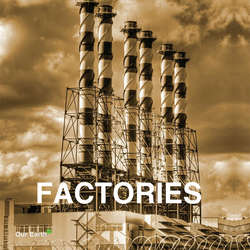Читать книгу Factories - Victoria Charles - Страница 4
На сайте Литреса книга снята с продажи.
Old Factories
ОглавлениеOld factory in Allaire Village, New Jersey, U.S.A.
A factory and sheep, Keynsham, Somerset, England.
Industrial smoke from a large chimney.
Old steel mill in winter.
Steel is a metallic alloy, essentially composed of iron and carbon. Produced using blast furnaces, cast iron, from which steel is extracted, is refined using a heating process called decarburisation, which makes it possible to remove any impurities. Alloying the material with elements like manganese, nickel, chromium and vanadium produces steel. The largest steel mill in the world can be found in Gwangyang, in South Korea.
Cityscape, Birmingham, England.
Factory in a harbour, Aarhus, Denmark.
Entrance to Zollern mine, Dortmund, Germany.
More and more coal mines have been abandoned in recent decades. Rich in industrial history, some former coal mines have even been turned into tourist attractions. Nowadays, some former mines invite tourists to have a closer look at their interesting history. At the time of its commission, the Zeche Zollern in Dortmund (pictured at left) was a classic example of a coal mine. The “Castle of Work”, as it was called, was a model of architecture, audaciously exhibiting a mixture of Historicism and Art Nouveau styles, and technical prowess, as it featured the first electrical hoist.
Old brick factory with chimney.
Almost all of the buildings that were constructed during the Industrial Revolution in England, including most factories that date from this time, were made out of brick. The 19th-century architecture of New York and Boston also demonstrates a preference for brick above other construction materials. The oldest bricks were found in the upper Tigris region. The Roman tradition of using fired bricks spanned centuries, and the principle can still be found in brick construction in southern and western Germany. The Gothic brick style, which evolved in Northern Europe in the 12th century due to a lack of available natural stone, can still be found in Denmark, Germany, Poland and Russia.
Multi-storey penthouse on the roof of an old factory.
A Victorian mill, now lying in ruins at Sneinton, Nottingham, England.
During the Victorian era, the city of Nottingham was known for its production of bicycles, but most particularly for textiles. The city became an important centre for lace manufacturing, as a result of its abundant machinery. However, after World War II, Britain could no longer compete in price with textile companies in Asia, and the once-flourishing enterprises in this part of the country vanished completely. In honour of its local manufacturing history, the city of Nottingham has made efforts to refurbish several of the old factories in the region.
Antique factory gate, Łódź, Poland.
The thriving textile factory in Łódź was established by Izrael Poznanski in 1852. Constructed using red brick, its architecture already hints at the lines that would characterise Art Nouveau at the end of the century. From 1872 to 1892 the factory was transformed into a miniature city, including a complex of twelve different textile factories, tenements for workers, a fire station, a power plant and Poznanski’s own estate from which he oversaw the operations of his textile empire. After Poznanski’s death in 1900, his sons managed the business, and the company continued to prosper. However, around World War II, the company was nationalised by the government and renamed Poltex. Instead of manufacturing fine textiles to ship all over the world, Poltex manufactured mass quantities of cotton for the increasingly powerful Soviet Union. The factory eventually closed in 1997 due to the dissolution, a few years earlier, of the Comecon trade agreements between several of the communist Eastern European states and the fall of the Soviet Union.
In 2000, plans to transform the factory complex into a supermall commenced, and Manufaktura opened in 2006. In order to adhere to the original style, most of the buildings are constructed with the restored red brick. It was quite an extensive project: the complex measures more than 90,000 square metres. Currently, Manufaktura hosts a mall, a fine foods and exports grocery, a factory museum, a local history museum, an Imax theatre, an aquarium, a science centre, a nightclub and even a hotel. Manufaktura has helped to revitalise Łódź’ economy, and despite the current global economic recession, Poland has experienced more economic growth than any other country in the European Union.
Carlsberg Brewery, Copenhagen, Denmark.
The headquarters of the Carlsberg Brewery, are located in Copenhagen, Denmark. Founded by J. C. Jacobsen in 1847, today the brewery ranks as one of the world’s largest. The Carlsberg Laboratory, which includes a Chemistry and Physiology department, deals with scientific problems related to brewing. The company has two other breweries in addition to their impressive headquarters, both located in China.
Façade of an old factory building.
West side of Andel’s Hotel, Łódź, Poland.
In Łódź, part of the former mill, founded by 19th-century textile magnate Izrael Poznanski, was converted into a four-star hotel, Andel’s Hotel. In addition to the red brick façade, the original cast iron gate with its clock, formerly the main entrance to the factory and today one of the city’s most important landmarks, has been preserved as well. The former textile complex was larger than the modern-day hotel and currently houses the commercial and entertainment centre known as Manufaktura (pictured). Thanks to the work of British architects from the firm Jesitco + Whiles, the building features an interesting blend of styles, with modern design complimenting the authenticity of the original location. The hotel has a glass-domed swimming pool on the roof that offers a great view of the city of Łódź.
Chocolate factory, Moscow, Russia.
White factory reflected in water.
Old factory, Nuremberg, Germany.
Old plant from the 19th century, St. Petersburg, Russia.
Old factory chimney.
Old factory renovated, Pittsburgh, Pennsylvania, U.S.A.
Конец ознакомительного фрагмента. Купить книгу
